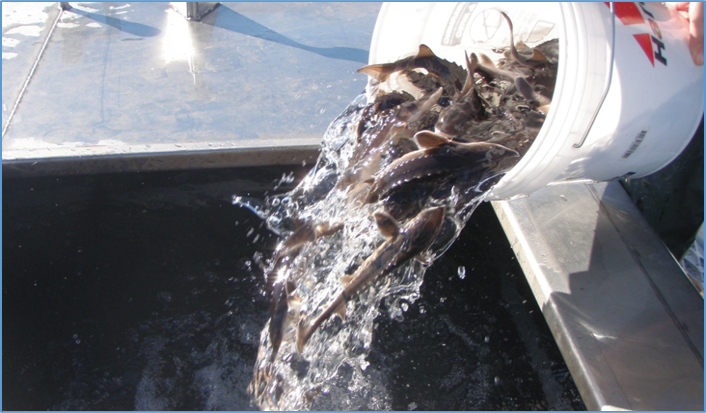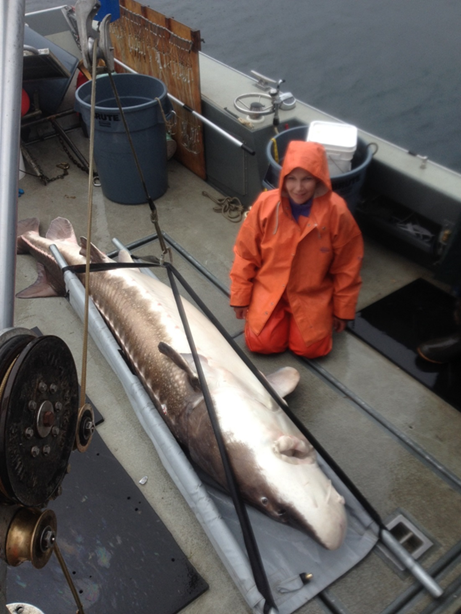Help for Upper Columbia Sturgeon
A multi-jurisdictional effort aims to add more juvenile fish to the aging Upper Columbia White Sturgeon population, but survival in the wild remains a problem.
- September 14, 2017
- John Harrison

There is a problem with White Sturgeon in the middle and upper reaches of the Columbia River, and it won’t be solved quickly. It’s not that the sturgeon are absent or even declining but that there aren’t many wild, juvenile fish, Jason McLellan of the Colville Confederated Tribes told the Council at a meeting in Spokane this month.
This “persistent recruitment failure,” as biologists call it, has been evident with sturgeon in several hundred miles of the Columbia in Washington and British Columbia since the early 1980s. By the early 2000s, when it did not appear to be improving, a recovery plan was devised by the Upper Columbia White Sturgeon Recovery Initiative (UCWSRI) in 2002 with representation by provincial, state, federal, tribal, and First Nations sturgeon experts. The plan has three objectives: to 1) determine population status, 2) implement conservation aquaculture, and 2) research causes of recruitment limitation.
At that time, the population was estimated at about 3,000 fish, most of them adults. Without more juvenile fish, the species likely would continue to decline further. The conservation aquaculture (hatchery) program began in British Columbia in 2001 and in Washington in 2004. Initially, wild adult sturgeon were caught and then spawned in hatcheries in British Columbia and eventually Washington. Juveniles were released into the river at roughly one year of age.

An adult sturgeon. Photo: Spokane Tribe of Indians.
Fearing hatchery-bred fish might not represent the genetics of wild fish in the river, in 2011 researchers began using only wild fish larvae in the hatchery. Since then, more than 149,000 wild larvae have been collected for rearing in Washington.
Hatchery sturgeon survived well – perhaps too well. The progeny, ranging from a high of about 16,000 to a low of about 2,000 juvenile fish per year, were released into the river, and over time the hatchery component of the population reached an estimated 31,000 fish age 5 or older – enough to allow a limited fishery.
While this sounds like success, concern remains. It appears sturgeon in the wild still are not producing very many juvenile fish, McLellan said. Survival of age 1 juvenile fish released from the hatcheries is high -- more than 50 percent -- and thousands of larvae are captured within a couple of weeks of hatching suggesting the survival bottleneck for wild white sturgeon is within the first year of life.
Why is that?
McLellan said researchers have identified a number of potential causes of the recruitment failure: dam operations changed the natural river flow pattern that reduces larvae drift distance and duration; slower flows because of dam operations means there is more silt on the river bottom and less clean substrate where sturgeon yolk-sac larvae hide; predators including birds and fish (Walleye and Sculpin, primarily) kill juvenile sturgeon; the food supply in the river may be insufficient; and toxic contaminants in the water including heavy metals from a smelter just across the border in British Columbia may be affecting fish.
Similar to the Upper Columbia, there are efforts to improve white sturgeon populations in the middle Columbia River reservoirs, as described by Paul Anders, a consultant who works on the sturgeon project for the Yakama Nation. These areas also have sturgeon population segments that experience recruitment limitation analogous to the upper Columbia population. There are efforts by the Yakama Nation, Washington Department of Fish and Wildlife, Colville Confederated Tribes, and the three PUDs – Grant, Chelan and Douglas – to enhance and restore these populations.
Anders said working with sturgeon, which can live up to 100 years, is different from working with salmon and steelhead.
“You sort of have to shift out of the salmon realm and use longer time periods for sturgeon,” he said.
While the project’s ultimate goal to restore the demographics, preserve genetic diversity, and restore natural recruitment (production) of upper Columbia White Sturgeon is not elusive, it will take time to achieve.
“It would be nice not to have to rely on the hatchery for the production of these fish, but for now we do,” he said.



